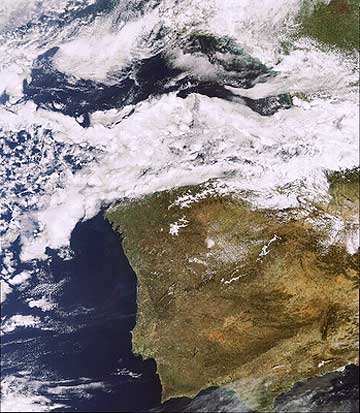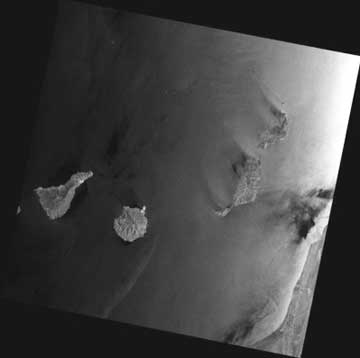
Envisat’s Medium Resolution Imaging Spectrometer (MERIS) captured this image on April 8, 2012, at 13:05 CEST. The image was transmitted in Ka-band to ESA/ESRIN though direct transmission via Artemis, the ESA Data Relay satellite. The image, which is of nominal quality, shows Portugal and Spain. It is the last Envisat data transmitted via Ka-band before the communication anomaly affected the Envisat satellite. Credits: ESA
...sending data to Earth. ESA’s mission control is working to re-establish contact with the satellite. Although this landmark mission has been in orbit twice as long as it was designed for, ESA hopes to keep the satellite in service until the launch of the successor Sentinel missions.
The first sign that there was a problem came on April 8th when contact with the satellite was unexpectedly lost, preventing the reception of any data as it passed over the Kiruna ground station in Sweden. ESA’s mission control team declared a spacecraft emergency and immediately called for support from additional ESA tracking stations around the world. A team of operations and flight dynamics specialists and engineers was quickly assembled. In a concerted effort, the recovery team, which included experts from industry, spent the next days trying to re-establish communications with the satellite.

Envisat’s Advanced Synthetic Aperture Radar (ASAR) captured this image on April 8, 201,2 at 13:09 CEST. The image was transmitted in X-band to the Santa Maria station in the Azores, Portugal, operated by Edisoft. The image, which is of nominal quality, shows Spain’s Canary Islands. It is the last Envisat data transmitted via X-band before the communication anomaly affected the Envisat satellite. Credits: ESA/Edisoft
Envisat has exceeded its planned life of five years by far. Since it was launched in 2002, this remarkable satellite has orbited Earth more than 50 000 times delivering thousands of images and a wealth of data to study and understand our changing planet, establishing itself as a landmark success in observing Earth from space. As the world’s most complex Earth observation satellite, Envisat carries 10 sophisticated instruments that have provided key information about our land, oceans, ice and atmosphere. Combined with data from the ERS missions since 1991, Envisat has provided precise measurements on climate change over the last 20 years. More than 4000 projects in over 70 countries have been supported with Envisat data. Data in the archives will continue to be available for users.
A contingency agreement with the Canadian Space Agency on Radarsat will be activated in order to continue to serve some of the user requirements if the problem with Envisat persists. Volker Liebig, ESA’s Director of Earth Observation Programmes, said, “The interruption of the Envisat service shows that the launch of the GMES Sentinel satellites, which are planned to replace Envisat, becomes urgent.”
The first of the new series of Sentinel missions for Europe’s Global Monitoring for Environment and Security programme is ready for launch next year. The Sentinels will provide the data needed for information services to improve the management of the environment, understand and mitigate the effects of climate change and ensure civil security.

